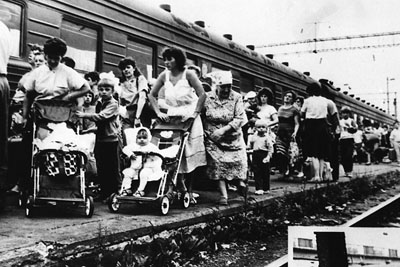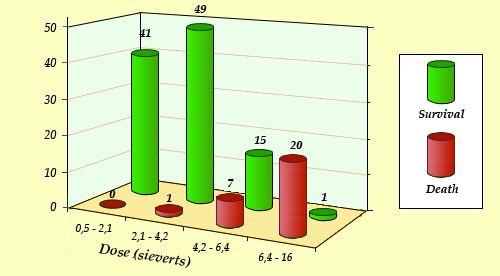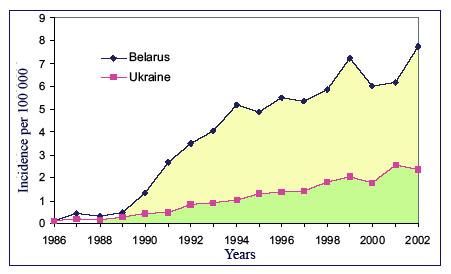Chernobyl: A toll still impossible to quantify

Iodine-131 and thyroid cancer among children
Ukrainian children from the most contaminated areas near Chernobyl sent in 1986 for medical treatments. Cancers of the thyroid due to radiation from radioactive isotopes of iodine affected mainly children and adolescents who are the most sensitive. Many European countries including France, have received some of these children. Deaths were few; almost 99% of these cancers having been cured. It is too early to comment on possible further consequences.
© Ukrainian Society for Friendship and Cultural Relations with Foreign Countries
It is difficult to reach an approached assessment of health consequences of the Chernobyl accident. Apart from the direct and immediate effects observed on people who on the site at the time of the disaster, diseases such as cancers occur years after exposure. These cancers are not specific to exposure to radioactive substances. To assess their number, one must identify an excess of cancers in exposed populations compared to unexposed populations: a delicate task that requires large scale monitoring over decades and an efficient health system.
The main victims are among the 6 to 7 million people living near Chernobyl in Ukraine, Russia and Belarus. Among this population, an epidemic of thyroid cancers is clearly attributable to the accident. The thyroid produces hormones essential in particular to ensure the teenagers and children development. It uses iodine, a mineral found in food, to make these hormones. A review by international experts published in 2005 reported 4000 cases among children and adolescents who were under age of 18 in 1986. Among these 15 were fatal. Since the disease is rare at this age, the thyroids cancers in the Chernobyl region are undoubtedly caused by the disaster.

Early deaths at Chernobyl
The personnel present near the reactor when the Chernobyl accident occurred and the emergency crews who intervened at the peril of their lives in the first moments were the most exposed. In total, 163 people received very strong irradiations, similar or superior to one sievert. Of these 163 people, 28 died as a result of this exposure in the days and weeks that followed. Among survivors, 11 additional deaths have been observed for the period 1988-1998, including 8 for diseases that have no connection with ionizing radiation.
© Source IRSN
The number of cancers at Chernobyl is generally calculated from those observed after Hiroshima and Nagasaki through a rule of proportionality : this much Sieverts give this much deaths, etc. These assessments are to be used with caution. The blind use of a rule of proportionality masks large uncertainties.
The circumstances are not comparable. At Hiroshima and Nagasaki, aside from, after the the blast effect and burns due to the bomb explosion, it was the intense « prompt » neutron and gamma radiation that caused deaths. In the case of Chernobyl, there was no such neutrons and radiations have been issued with much lower rates and doses.

Thyroid cancers in Ukraine and Belarus
The epidemic of thyroid cancers that developed after 1991 in children and adolescents in Ukraine and Belarus is clearly linked to the accident. It would have been possible to reduce the number of these cancers by distributing in time iodine tablets to the most sensitive people.
© The Chernobyl legacy (AIEA-2006)
According to the report of experts published by the IAEA in 2006, 9300 fatal cancers attributable to Chernobyl accident may occur during their lifetimes, among the inhabitants of the former USSR and the liquidators. It will be difficult to determine the real number of deaths from these cancers, which are indistinguishable from those caused by the other risk factors. According to the categories, these additional deaths represent 0.6 to 5% of normally expected cancer deaths.
Apart from thyroid cancer, increases in morbidity and mortality due to circulatory problems have recently been reported among the liquidators who had participated in emergency actions and cleanups. These incidences of circulatory problems should be interpreted with caution, as they may be confused with causes other than radiation such as stress or dangerous lifestyles or consequences of the trauma of inteventions on the site.
No increase of leukemia – yet expected by experts – has been observed to date among the population of the most affected countries and among the « liquidators ». Similarly, there was no clear increase in birth defects in the most contaminated areas.
The non-observation of a clear excesse of cancers, many of which have not yet been declared, does not mean an absence of effects. A slight increase cannot be detected using existing means. On the contrary, the psychological consequences of the disaster are clear: the accident, the anguish of living or having lived in a contaminated environment has severely affected the existence and behavior of populations.
Other articles on the subject « Chernobyl accident »
Chernobyl Circumstances
An explosion followed by a graphite fire In 1986 the Ukrainian Chernobyl plant had 4 RBMK reactor[...]
Chernobyl Liquidators
A heavy toll paid by firefighters and liquidators: The magnitude of the disaster took the Soviet [...]
Radioactive Releases
Radioactive releases and contaminations at Chernobyl The explosion of the reactor led to the disp[...]
Chernobyl Plume
A deep mark in the french collective unconscious « The Chernobyl cloud has stopped at the french [...]
Chernobyl Exclusion Zone
A no man’s land turned into a natural reserve ? On April 27th, 1986, one day after the expl[...]
Chernobyl Iodine 131
A dangerous radioelement during the first weeks Iodine-131 is the most feared fission product whe[...]
Chernobyl Caesium-137
The accident long term legacy More than twenty years after the Chernobyl accident, attention focu[...]
Chernobyl Today
The Chernobyl Site Over 30 Years Later On December 15, 2000, the Ukrainian government, in accorda[...]